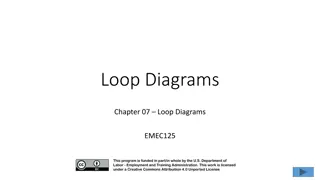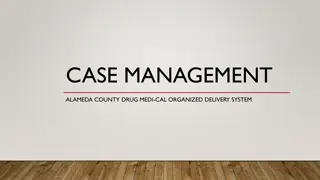Enhancing Care Coordination: A Path to Improving Referrals and Closing the Loop
Explore the journey towards building a cohesive medical neighborhood for effective care coordination. Uncover prevalent challenges in referral processes, the importance of closing the loop, and the impact of referral tracking on reducing incomplete referrals and enhancing patient outcomes.
- Care Coordination
- Referral Management
- Healthcare Connectivity
- Patient Referrals
- Medical Neighborhood
Download Presentation

Please find below an Image/Link to download the presentation.
The content on the website is provided AS IS for your information and personal use only. It may not be sold, licensed, or shared on other websites without obtaining consent from the author. Download presentation by click this link. If you encounter any issues during the download, it is possible that the publisher has removed the file from their server.
E N D
Presentation Transcript
An Invitation to start building The Medical Neighborhood Connecting Care: Ensuring Quality Referrals and Effective Care Coordination Office Hours ACP SAN special project for implementing High Value Care Coordination June 12, 2019
The ACP SAN High Value Care Coordination curriculum Action Steps to Connected Care 1. Look at your internal referral process (get your own house in order) what is your current state? 2. Ensure the specialty practice gets what is needed for a high value referral 3. Ensure the others (patients, the requesting practice and any secondary care) get what they need 4. Develop Care Coordination Agreement(s) (compact) with appropriate referring practice(s) 2
What we learned from step 1. Major log jam around the referral loop: No established process for closing the loop not consistently done - PC has to call repeatedly to get referral response notes large time sink increased work burden & disruptions Variation in the way referral requests come in Multiple copies of same referral or one referral in multiple different faxes large time sink increased work burden & disruptions errors Prior authorization issues with referrals Not well coordinated with the referral request & appointment scheduling Lots of back and forth appointments cancelled for patients Large time sink increased work burden & disruptions Can t be fixed by any practice by itself need to work out the workflow solutions together collaborationin process (potential to save time & work burden in addition to expedite the referral process) 3
Referral Tracking to Close the Loop helps Reduce Incomplete Referrals & Improve Outcomes Referral request sent, logged & tracked Referral request received and reviewed Referral accepted with confirmation of appointment date sent back to referring practitioner Referral declined due to inappropriate referral (wrong specialist, etc) and referring practice notified Patient defers making appt or cannot be reached and referring practice notified Referral response sent (must address clinical question/reason for referral) Referral Note sent to referring clinician and PCP in timely manner Notification of No Show or Cancellation (with reason, if known) Referrals made from one specialty to another (e.g. secondary referrals) include notification of the patient s primary care clinician 4
Idea Sharing Any one stuck on these challenges? What is working? Any volunteers willing to share what they are working on with sending and receiving referral requests (& referral response notes)? Any other practice groups want to join these efforts or work with another practice on similar efforts? 5
Action Steps to Connected Care GIVE the SPECIALTY PRACTICE WHAT IT NEEDs Ensure the specialty practice gets what is needed for a high value referral Define basic referral request elements Establish referral guidelines Urgency Pertinent Data Sets/ supporting information Ensure Pre-consultation / Pre-visit review & request 6
Referral Information What is the specific clinical question (reason for referral) A brief Summary of case details pertinent to the referral, include relevant co-morbidities (alarm signs or symptoms) Urgency (referral status or referral priority) Referral Type (anticipated, pending specialist s evaluation) (Definition of care or Role in care requested of the specialist) Pertinent data set: Clinical information directly relevant to the specific referral question (office notes, test results, etc.) (Supporting data for the referral) Core Medical Data (med list, allergies, past med & surg hx, pain agreement, etc.) 7
Referral Type (What is the suggested role of the specialist) ____ Consultation (cognitive) (Evaluate and Advise, with the goal of managing the problem remaining with the referring clinician) ____ Procedural Consultation ____Co-Management with Shared Care (Referring clinician (e.g. PCP) maintains first call for the referral disorder) ____ Co-Management with Principal Care (Referred to subspecialist/specialist assumes first call for the referral disorder) __I prefer to manage this condition once stable on care plan __I prefer that you (specialty care) manage this condition on on-going basis ____ Please assume Full Responsibility for Complete Transfer of all Patient Care (e.g. Pediatric to Adult care transition or a move) 8
The requesting practice needs to know - what is pertinent Establish referral guidelines (Pertinent Data Sets) Define: Information needed Testing needed Therapeutic trials What not to do Alarm signs & symptoms Urgency 9
What we learned from step 2. Identified need for: a clinical question or reason for referral and not just an ICD code SC often does not know why patient referred or what concern is PC using the ICD code & its definition wording, not actual clinical question/ reason pertinent supporting data set for the referred condition (referral guidelines) SC often does not have the info they need with the referral indication of the role desired of SC (e.g., consult, co-management, etc.) & an indication if PC is comfortable resuming management of the condition once stable or not - SC access reduced by ongoing SC management for patients that could be managed by PC/other SC EHR doesn t allow adding the needed info customization needed Reducing Inappropriate referrals issues that could be handled by PC Internal process needed to improve APP discussing with physician before referring 10
Proposed Solutions Require Clinician Involvement Clinical question/detailed reason for referral with every referral Provided with every referral request Addressed by every referral response Agree on use of definitions of care/ roles for specialty care Primary care request desired specialty care role Specialty care acknowledge (agree with or suggest another option) & indicate role on patient chart Referral guidelines for common or critical referral conditions Specialty care develop vetted with primary care Primary care determine how to incorporate into referral process Could be aided by use of common referral request form or checklist Agreement on definitions for SC roles - Next step - Care Coordination Agreement Requesting practices need to know what is needed for specific conditions Option work in Dyads to develop 11
Idea Sharing Any one struggling with these issues? Any volunteers/dyads willing to share what they are working on regarding referral guidelines? Or including a clinical question? Or reducing inappropriate referrals? Any other practice groups want to join these efforts or work with another practice for solutions? 12
Action Steps to Connected Care Ensure others get what they need Ensure the others get what they need Ensure the patient is part of the process & their needs are met with a patient-centered approach Ensure the Requesting Clinician / Care Team get their needs met Provide a high value referral response Establish close-the-loop referral tracking process Ensure appropriate & high value Secondary Referrals 13
Patients take the brunt of the impact for poor referral processes Do not get the time they want or need with the appointment Do not get questions asked or answered; confusion, concerns, etc. Worse outcomes Lost time (patient s time is proposed quality metric) Cost from lost wages, co-pays, deductibles With high deductible plans, patients pay for duplicated, unnecessary care Cost of travel, parking, baby sitter, etc. Delay (hefty cost to mental & physical health) Worry Unable to work, reduced ADL Unresolved or Worsening condition Often get the blame for lack of information with the referral Safety issues 14
The Referral Request - Prepared Patient Patient aware of and in agreement with referral with appropriate expectations (opportunity for Shared Decision Making) Is patient willing to participate in the referral Does patient understand & agree with the reason for referral and understand what additional expertise is needed and why Alert specialty care practice of any special considerations or needs for patient / family Language/communication/transportation needs. Impaired vision, hearing, cognition, ambulation, etc. Caregiver status parent, spouse, adult offspring, case manager, Patient specific goals Information for the patient/ caregiver about the referral Explaining type of specialty care or procedure Information on referral condition or concerns Flyer from specialty practice about the practice* 15
Template for One Pager for Patient about the Referral - Reduce the Unknowns Patient name_________ Referred on________ Reason for Referral:____________________ Patient Goal____________ Type of referral(role requested of specialty care)*: (recommend have options to be circled) To: Practice name/ physician name(s) - Practice address & phone Info about practice: including link to website for additional info Role Requested of you -the Patient/Caregiver: Wait to be contacted, what to do if... .. Appointment scheduling: will SC practice call, time frame to expect, etc. Visit preparation: Previsit forms, who /what to bring, fasting for test, etc. What to expect: what care team members involved, time allotment, etc. Directions: (bus & train routes & stops; parking & costs; door entrance, elevator bank, floor, etc.) 16
The Referral Response: Ensure the Patients Needs are Met Scheduling considerations Use Pre-consultation review to ensure the referral is appropriate & to ensure receipt of needed information Schedule patients according to urgency of their referral needs Previsit preparation Utilize the information sent with the referral to pre-populate the core medical items such as med list, allergies, surgical history, etc. to reduce patient burden then confirm with the patient Provide on-line option or at least at home option for filling out needed forms before the appointment Review of clinical question & supporting data as pre-visit prep by clinician Recommend that clinician share with the patient that they are aware of why the patient was referred and that they have reviewed their records vs asking so tell me why you are here today 17
18 A High Value Referral Response is Critical for Information Exchange & Continuity What the specialist is going to do What the patient is instructed to do What the referring physician needs to do & when Answer the clinical question/address the reason for referral-Summary (include some thought process) Agree with or Recommend type of referral / role of specialist Confirm existing, new or changed diagnoses; include ruled out Medication /Equipment changes Testing results, testing pending, scheduled or recommended (including how/who to order) Procedures completed, scheduled or recommend Education completed, scheduled or recommended Any secondary referrals made (confer with and/or copy PCP on all) Any recommended services or actions to be done by the PCP/PCMH Follow up scheduled or recommended Clear indication of Easy to find & refer to in the response note 18
Ensure Appropriate & High Value Secondary Referrals - Avoid the Referral Black Hole Secondary referrals arise from a referral request to another specialty/ subspecialty practice for consultation, procedures, or co-management by a specialty practice (by one specialty practice to another specialty practice) In some instances, the referral for additional special services may require some specialty knowledge and may expedite care & best be managed by the specialty/subspecialty practice There needs to be clear expectations for when the PCP wishes (or is required by insurance plan) to be involved in secondary referrals In all cases, the PCP needs to be included in the communication regarding the secondary referral 19
What have we learned about step 3? Are there gaps in considering the patient in the referral process? (a patient-centered approach) Do the referral response notes provide all the needed information? Is there any problem around secondary referrals? (the referral black hole) 20
Idea Sharing Any ideas for what your practice does well or needs work on for these items? Any volunteers willing to share what they are considering or working on to make the referral process more patient-centered? Any work on the referral response elements? Any other practice groups want to join these efforts or work with another practice to improve processes? 21
What do you need to connect the care? Interoperability is a tool Improving the referral process requires us: High Value Care Coordination Information Sharing Communication Collaboration Patient-Centered Approach 22























